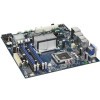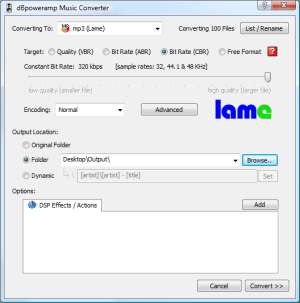- Qualcomm Launches Snapdragon 4 Gen 2 Mobile Platform
- AMD Launches Ryzen PRO 7000 Series Mobile & Desktop Platform
- Intel Launches Sleek Single-Slot Arc Pro A60 Workstation Graphics Card
- NVIDIA Announces Latest Ada Lovelace Additions: GeForce RTX 4060 Ti & RTX 4060
- Maxon Redshift With AMD Radeon GPU Rendering Support Now Available
Intel Desktop Board DG45ID

We’re taking a look at Intel’s first attempt at a full-featured media center motherboard, the DG45ID. It’s also our first look at their new G45 Express chipset, which promises to finally bring DX 10 support and hardware-accelerated HD video playback to their integrated graphics offerings. Can the DG45ID prove itself a worthy choice for your HTPC?
Page 7 – Multi-Media: Multi-Media: Music Encoding, Blu-Ray Playback
Today’s CPUs make short work of audio compression and encoding, but it remains an important and consequential performance metric for anyone who works with a large library of digitally-stored music. Even the most uptight audiophiles have begun to embrace lossless encoding of digital sources, and this has led to a proliferation of PC-based audiophile music servers as well.
To examine the handling of large amounts of audio data in an encoding or transcoding operation, we employ Illustrate’s dBpoweramp music converter. Encoding places demands on the CPU-memory link, as well as the storage subsystem, but in the development of our methodology, we found the storage aspect to be far more variable, and less consistent, so we focus on a benchmarking application developed by Illustrate that uses dBpoweramp’s compression engine, and doesn’t involve the storage subsystem at all.
Our battery of music compression tests is automated by a batch file, and tests encoding in both FLAC and MP3 file formats. (For a breakdown of the differences between common encoding formats, check out our article.) First, a conditioning run of each test is performed, and then a data-collection run for both tests. This is done to ensure the most consistent results possible. Data is then recorded to an output text file for each compression format, though both tend to scale consistently.

Strangely enough, the Intel DG45ID finds its footing here and completes the FLAC encoding task one second faster than the P5E-VM, though the MP3 encoding task takes two extra seconds on the Intel board. This may have something to do with differing usage of memory for the LAME encoder when compared to the FLAC encoder, though it is a slight break from our typical result scaling. The results are extremely consistent for multiple trial runs, so the numbers presented here are valid.
Blu-Ray Playback: ArcSoft TotalMedia Theatre
Now that the HD format war has subsided, we can all breathe a sigh of relief and begin thinking seriously about how to integrate high-definition video playback into our home theater systems. The home-theater PC figures into that in a big way, but even enthusiast PCs will likely be tasked with Blu-Ray playback on the desktop, and notebook PCs are just now beginning to be capable of playing back a complete Blu-Ray movie on a single charge.
Hardware acceleration of high-definition video decoding plays a large part in the Blu-Ray experience on your PC, offloading the decoding task from the CPU and ensuring stutter-free and artifact-free HD playback. This is especially important in cases where the PC must handle multiple CPU-intensive tasks simultaneously, such as recording HD television while watching a Blu-Ray movie – an entirely reasonable usage scenario for a home theater PC.

In light of this, we’ve incorporated a Blu-Ray playback test that compares CPU usage in ArcSoft’s TotalMedia Theatre media player. We chose the ArcSoft solution after comparing the various player packages available, thanks to its broad support for a variety of GPU acceleration implementations. The purpose here is to compare CPU usage between different motherboard IGPs while decoding a Blu-Ray movie. The movie we selected is Disney’s Pirates of the Caribbean: At World’s End, which is encoded in the H.264 format. For comparison’s sake, we’ve also tested the motherboard under review with our reference NVIDIA GeForce 9600GT discrete GPU.

In this test, the Intel G45 Express chipset’s built-in GMA X4500HD graphics core significantly relieves the CPU of the decoding task, while the G35’s GMA X3500 graphics core (which lacks hardware acceleration for H.264 decoding). However, the discrete NVIDIA GeForce 9600GT GPU provides even more effective hardware acceleration, with the CPU load from Blu-Ray playback cut to single-digit values. The Intel DG45ID motherboard makes more sense than a G35-based solution if you’re planning a machine that’ll be used to play Blu-Ray movies in the future, though there’s still more performance to be gained from using a discrete GPU from either the ATI or NVIDIA camp.
Support our efforts! With ad revenue at an all-time low for written websites, we're relying more than ever on reader support to help us continue putting so much effort into this type of content. You can support us by becoming a Patron, or by using our Amazon shopping affiliate links listed through our articles. Thanks for your support!





